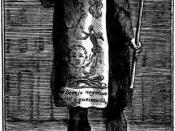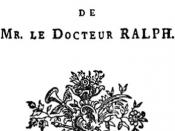A Commentary on chapter VI of Voltaire's Candide relating its style and themes to the work as a whole Chapter VI: Comment on fit un bel auto-da-fÃÂé pour empÃÂêcher les tremblements de terre, et comment Candide fut fessÃÂé Chapter VI begins with Voltaire using an ironic style in explaining the reason for the auto-da-fÃÂé. Following the Lisbon earthquake the authorities decided, on advice from the University of Coimbra, that to prevent a further disaster, [which could destroy the whole city] that only a grand and ceremonious auto-da-fÃÂé would be sufficient - only a burning will suffice, and moreover this is must be executed with necessary grandeur. Voltaire's corrosive irony attacks the institutions of religion and education. Religion and education [in the form of the University of Coimbra in this case] were intimately linked at that time, as religion ruled over knowledge. Voltaire's attack in the form of irony is used to denounce them, he continues to do so by exhibiting their simple-mindedness in the form of their lack of judgement in less complex matters: the reason for Candide's imprisonment [Pangloss' imprisonment being less demonstrative, though nevertheless still emphasising the point] ""æOn vint lier aprÃÂès le dÃÂîner le docteur Pangloss et son disciple Candide, l'un pour avoir parlÃÂé, l'autre pour l'avoir ÃÂécoutÃÂé avec un air d'approbation"æ" The transformation of religious intolerance is demonstrated well in the opening paragraph.
A product of fear, it mutates into superstition and the outlet for this superstition is the mistreatment of fellow human beings. Voltaire deliberately avoids details of the mistreatment in the form of the auto-da-fÃÂé, leaving the reader open to imagine the horror of the slow torture [namely burning alive] seen as a ceremonial practice that is the auto-da-fÃÂé. This style of modesty and simple description continues in the description of the victims of...


